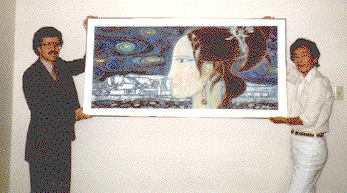Attorney Carl Shusterman and Chinese Artist Shao-Kuang Ting
Shao-Kuang Ting, the noted Chinese artist, presents his painting “Lost Love” to his attorney Carl Shusterman after receiving the right to reside legally in the US.
A native of the Peoples Republic of China, Ting was granted a single-entry visa to visit his mother in the US in the early 1980s. Mother and son were separated during the Communist Revolution of 1949.
While in the US, Ting’s American friends asked him to accompany them on a day trip to Tijuana, Mexico. Ting was afraid to do so, informing them that he had a “single-entry” visa, and that if he left the country, he would not be allowed to re-enter the United States.
His friends, knowing nothing about immigration laws and procedures, assured him that this would not be an issue. They told him that they would ask a Border Patrol officer about this before leaving the U.S.
However, Ting fell asleep in the back seat of the car. His friends, not wanting to wake him up, and believing that he was worried about nothing, simply kept driving until they arrived in Tijuana.
When they attempted to cross the border back into the US, INS officials refused to allow Ting to re-enter the country since his visa only permitted him to enter the country once.
Client Reviews

Life Saver
“After wasting thousands of dollars on other lawyers, Mr. Shusterman was life saver. I recommend him hands down!”
- Mukta Mohan, Buffalo, New York
Read More Reviews
Zoom Consultations Available!
He was forced to remain in Tijuana by himself.
Ting’s friends drove back to Los Angeles where they contacted Congressman John Rousselot for help. The Congressman contacted immigration attorney Carl Shusterman who agreed to meet with Ting’s friend.
Attorney Shusterman came up with a novel remedy to try to get the Chinese artist back into the United States.
Arguing that the “Chinese Picasso” was being denied entry into the US, Shusterman persuaded the INS District Director in Los Angeles to issue a “parole” which allowed his client to reenter the US.
When the INS District Director in San Diego inexplicably refused to honor the parole document, Attorney Shusterman arranged for Mr. Ting to board a flight from Tijuana to Los Angeles where he was admitted at LAX.
Later, Attorney Shusterman successfully fought to get Shao-Kuang Ting permanent residence in the US.
Mr. Ting was so grateful that he referred a number of other artists from the “Yunan School” to Mr. Shusterman who succeeded in obtaining green cards for each of them. Years later, Attorney Shusterman helped Shao-Kuang Ting obtain US citizenship.
Even today, over 25 years later, posters and paintings from Shao-Kuang Ting and other Yunan School artists adorn the walls of the Law Offices of Carl Shusterman. For more pictures of Attorney Shusterman with his clients, please see our photo gallery.
Read more of our Immigration Success Stories.
More About Chinese Artist Shao-Kuang Ting
- Contemporary Chinese Artist Yunnan School – Ting Shao Kuang
- Ting Shao Kuang, Chinese Artist, artwork list sortable by title, year, type …
- Ting Shao Kuang is an American-Chinese figurative painter and printmaker. Best known for his contribution to the Yunnan Art School style. His calligraphic works, paintings, and handcrafted serigraphs on paper, often featured a stylized woman surrounded by vibrant abstractions. The artist’s work draws heavily on both Ancient Egyptian and Art Nouveau aesthetics. Born on October 7, 1939 in Chenggu County, China, Ting received his formal art training at the Central Academy of Arts and Crafts in Beijing. After graduating, he taught at the Yunnan Art Institute in Kunming, China. Ting currently lives and works in Los Angeles, CA.
- Ting Shao Kuang, Chinese Artist, Christies
- Ting Shao Kuang as born in Chenggu, a village located in the Northern province of Shanxi, China in 1939. The year Ting was born, this area, which once was the center of an advanced civilization, was reeling from the ravages of the Sino-Japanese war. But as the war progressed, Ting’s father, a Kuomintang official in Beijing, helped rally the Nationalist forces, and the Japanese Imperial Army was eventually defeated.

